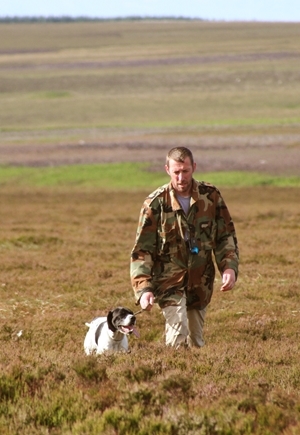 By Amber Hopgood and Andrew Hoodless
By Amber Hopgood and Andrew Hoodless
After 35 years of dedicated service with the Trust, Dr Dave Baines left the GWCT last week. Dave is an exceptional fieldworker and has been one of our most productive senior scientists, having been an author on over 110 scientific papers during his career. His extensive knowledge and insight on upland species and management issues will be sorely missed.
Dave came to the GWCT to lead our work on black grouse in Scotland and was soon involved in investigating the causes of decline in capercaillie. This work resulted in a much better understanding of the impact of deer fences and predation, still pertinent issues for capercaillie today.
Dave moved to Teesdale, County Durham, to become Head of Grouse Research in 1998 and then Head of Upland Research, overseeing key Trust projects including the Upland Predation Experiment at Otterburn and the latter phase of the Langholm Project. During his career he has published research on waders, red grouse and black grouse, capercaillie, raptors and issues such as ticks, louping ill virus, and upland habitat management.
He has been instrumental in ensuring the persistence of the GWCT’s long-term red grouse count dataset, black grouse lek counts and capercaillie monitoring. More recently, he has published key papers demonstrating the importance of predator control in maintaining the productivity and breeding densities of waders in the Pennines.
Dave has made a considerable contribution to sharing upland science with the wider scientific community, land managers and conservation practitioners. Over the years he has played a central role in organising and delivering thirteen Northern England Grouse Seminars, and has contributed to numerous blogs, Gamewise and Annual Review articles.
GWCT remains committed to researching upland issues, which seem as pressing as ever with restrictions on heather burning on deep peat, concerns about flooding and water quality, changes to general licences and new forestry planting targets. Major projects started under Dave’s guidance, such as our heather cut-burn experiment and heather cutting trials, led by Sian Whitehead, will continue in 2024.
A black grouse translocation study and assessments of woodland planting on black grouse and wader numbers, both funded by Natural England and led by Phil Warren, have commenced this winter. The results of the Merlin Magic project, funded through the Green Recovery Challenge Fund, indicate that declines in breeding merlin in northern England over the last 30 years are unlikely to have been driven by grouse moor management and that survival during the first winter is an important factor. This work has been discussed with practitioners through workshops and submitted for publication.
We are taking the opportunity to review our upland work, scope new opportunities and increase dialogue and collaboration between our research and advisory teams in the uplands and with universities. We will be recruiting for a new upland research team leader in the spring, to mentor the remaining team members and build upon Dave’s legacy.
Photo taken by Jo Stockdale